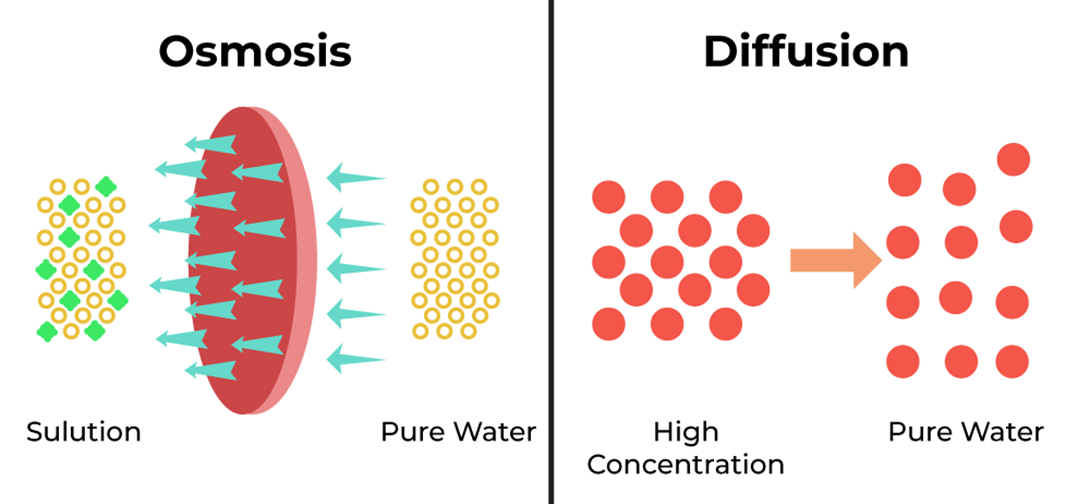In dialysis, the cleansing of wastes from the blood is achieved by
Movement of water into the blood from the dialysis solution
Simple diffusion across a semi-permeable membrane
Active transport across a semi-permeable membrane
Active transport of glucose from the blood to the dialysis solution
Facilitated diffusion across a semi-permeable membrane
The Correct Answer is B
Choice A rationale: Movement of water into the blood from the dialysis solution is incorrect because it is not the main goal of dialysis. Dialysis aims to remove excess water and solutes from the blood, not to add more water to it. The dialysis solution is usually isotonic to the blood, which means it has the same osmotic pressure and does not cause water movement.
Choice B rationale: Simple diffusion across a semi-permeable membrane is correct because it is the process of dialysis. Dialysis is the separation of small molecules from large molecules by using a membrane that allows only the small molecules to pass through. The dialysis membrane is semi-permeable, which means it is selective in what it allows to cross. The dialysis solution contains a lower concentration of wastes than the blood, which creates a concentration gradient that drives the diffusion of wastes from the blood to the solution.
Choice C rationale: Active transport across a semi-permeable membrane is incorrect because it is not involved in dialysis. Active transport is the movement of molecules across a membrane against their concentration gradient, which requires energy and transport proteins. Active transport is not necessary for dialysis, since the concentration gradient is favorable for diffusion.
Choice D rationale: Active transport of glucose from the blood to the dialysis solution is incorrect because it is not beneficial for dialysis. Glucose is a vital nutrient for the body, and it should not be removed from the blood. The dialysis solution usually contains glucose to prevent its loss from the blood by diffusion.
Choice E rationale: Facilitated diffusion across a semi-permeable membrane is incorrect because it is not relevant for dialysis. Facilitated diffusion is the passive movement of molecules across a membrane with the help of transport proteins. Facilitated diffusion is not needed for dialysis, since the wastes are small enough to cross the membrane by simple diffusion.
Nursing Test Bank
Naxlex Comprehensive Predictor Exams
Related Questions
Correct Answer is A
Explanation
Choice A rationale: Diffusion is correct because it is the passive movement of molecules from an area of high concentration to an area of low concentration. Small lipid soluble molecules can easily cross the plasma membrane by diffusing through the hydrophobic core of the phospholipid bilayer.

Choice B rationale: Filtration is incorrect because it is the process of separating solid particles from a fluid by passing it through a porous medium. Filtration does not involve the plasma membrane, and it does not depend on the solubility of the molecules.
Choice C rationale: Osmosis is incorrect because it is the diffusion of water across a selectively permeable membrane. Osmosis does not apply to lipid soluble molecules, which are not water molecules.
Choice D rationale: Active transport is incorrect because it is the movement of molecules across a membrane against their concentration gradient, which requires energy and transport proteins. Active transport does not depend on the solubility of the molecules, and it is not a passive process.
Choice E rationale: Pumping is incorrect because it is a type of active transport that involves the use of specific pumps to move ions or molecules across a membrane. Pumping does not apply to lipid soluble molecules, which are not ions or polar molecules.
Correct Answer is D
Explanation
Choice A rationale: Body tube is incorrect because the body tube is the part of the microscope that connects the eyepiece to the objective lenses, not the part that holds the objective lenses. The body tube is a hollow cylinder that allows the passage of light from the objective lenses to the eyepiece.
Choice B rationale: Stage is incorrect because the stage is the part of the microscope that supports the slide and the specimen, not the part that holds the objective lenses. The stage is a flat platform that has a hole in the center to allow the light source to illuminate the specimen.
Choice C rationale: Base is incorrect because the base is the part of the microscope that supports the whole microscope, not the part that holds the objective lenses. The base is the bottom part of the microscope that provides stability and balance.
Choice D rationale: Rotating nosepiece is correct because the rotating nosepiece is the part of the microscope that holds the objective lenses and allows them to be changed. The rotating nosepiece is a circular structure that has four or more objective lenses attached to it. The rotating nosepiece can be rotated to switch between different magnifications of the objective lenses.
Whether you are a student looking to ace your exams or a practicing nurse seeking to enhance your expertise , our nursing education contents will empower you with the confidence and competence to make a difference in the lives of patients and become a respected leader in the healthcare field.
Visit Naxlex, invest in your future and unlock endless possibilities with our unparalleled nursing education contents today
Report Wrong Answer on the Current Question
Do you disagree with the answer? If yes, what is your expected answer? Explain.
Kindly be descriptive with the issue you are facing.
